 W
WBeale Cottage is situated on the corner of Beale and Grey street in Hamilton, New Zealand. Constructed in 1872, it stands as one of Hamilton's oldest surviving homes. It was designed by one of Hamilton's first European settlers, Dr. Bernard Beale, and used as his family residence, surgery and registry office. Its importance derives from its connection with Beale and the beginnings of modern medical practices in Hamilton, thus giving reason for the Hamilton City Council to later declare the cottage as an Historic Reserve in 1994. It is also a Category I listing with the New Zealand Historic Places Trust.
 W
WBean Rock Lighthouse is a lighthouse situated at the end of a reef in the Waitemata Harbour in Auckland, New Zealand. It is the only remaining example in New Zealand of a wooden cottage-style lighthouse, and it is one of only a few remaining worldwide. It is also the oldest wooden lighthouse and only wave-washed tower in New Zealand. It is owned, operated and maintained by Ports of Auckland.
 W
WThe Canterbury Club is a historic gentlemen's club in the central city of Christchurch, New Zealand. It was founded by urban professionals in 1872 as a breakaway club from the Christchurch Club, which had been set up by large rural landholders in 1856.
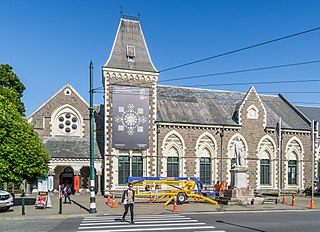 W
WThe Canterbury Museum is a museum located in the central city of Christchurch, New Zealand, in the city's Cultural Precinct. The museum was established in 1867 with Julius von Haast – whose collection formed its core – as its first director. The building is registered as a "Historic Place – Category I " by Heritage New Zealand.
 W
WThe ruins of Cargill's Castle stand on a promontory overlooking the Pacific Ocean in New Zealand's southern city of Dunedin. It is one of about ten castles in New Zealand, the other one in Otago being nearby Larnach Castle. More a castle in name than in fact, this Italianate mansion was built for Edward Cargill, eighth child of city founder William Cargill, in the late 19th century, who called it The Cliffs. Designed by the young architect Francis Petre, and built in concrete by Harry Lyders at a cost of £14,000, it was completed in 1877. Several kilometres south of the castle is Tunnel Beach, so named because this quiet beach is only accessible through a steeply sloping tunnel cut into the 60 metres (200 ft) high cliffs by the Cargill family. It is also very likely that Petre was the supervisor of the construction of the tunnel. While designing the house, Petre fell in love with Cargill's daughter Margaret. After a difficult courtship the couple were eventually permitted to marry, the wedding taking place in the villa's principal salon on 1 March 1881.
 W
WThe Chief Post Office or Christchurch Central Post Office, originally known as the Government Building, is located in Cathedral Square, Christchurch, New Zealand. The building was initially a post office with other government services. Until the 2011 Christchurch earthquake, it was a Visitor Information Centre but has since been inaccessible, as access for the public to the central city has been removed. It was the site of the first telephone exchange in New Zealand. The structure is registered with Heritage New Zealand as a Category I heritage building.
 W
WThe Chingford Stables are located in North East Valley, Dunedin, New Zealand. The stables are now used for both private and public functions, and listed as a Category I Historic Place.
 W
WThe Church of St Michael and All Angels is an Anglican church in Christchurch, New Zealand. The church building at 84 Oxford Terrace, Christchurch, is registered as Category I by Heritage New Zealand. Its freestanding belfry is registered separately.
 W
WCranmer Court, the former Christchurch Normal School, was one of the most significant heritage buildings in Christchurch, New Zealand. Its demolition, due to some damage in the 2011 Christchurch earthquake, was controversial.
 W
WThe Empire Hotel is a historic building at 396 Princes Street, Dunedin, New Zealand, located some 700 metres southwest of the city centre. Currently empty, it served as a public house from the 1850s until the 1990s. It has a New Zealand Historic Places Trust category 1 listing.
 W
WFairfield House in 48 Van Diemen Street, Nelson, New Zealand, is registered with the New Zealand Historic Places Trust as a Category I structure. Originally built in 1849, today's house was constructed as a residence for Arthur Samuel Atkinson in 1872. It was at some stage owned by the Nelson College for Girls, who used it as a boarding house. After the 1929 Murchison earthquake, boarders from Nelson College also moved in, as their hostel got damaged. The house was given to Nelson City Council in 1979 and was threatened with demolition. A community group formed that had the objective of saving the house. Alan Stanton moved into the derelict building as a squatter and started restoring it. Today, it is a community centre.
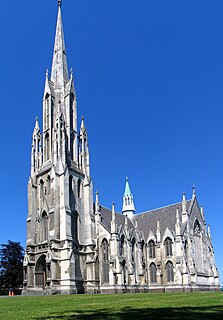 W
WFirst Church is a prominent church in the New Zealand city of Dunedin. It is located in the heart of the city on Moray Place, 100 metres to the south of the city centre. The church is the city's primary Presbyterian church. The building is regarded as the most impressive of New Zealand's nineteenth-century churches, and is listed by Heritage New Zealand as a Category I structure.
 W
WGolder Cottage is one of the oldest surviving colonial houses in Upper Hutt, New Zealand. The house is used as a museum of colonial domestic life.
 W
WGoldie's Brae is a historic building in Wadestown, Wellington, New Zealand classified as a "Category I" historic place by the New Zealand Historic Places Trust. It is considered remarkable for its relatively new construction material, concrete, and its eccentricity of design. It was designed by its original owner Dr Alexander Johnston, the Provincial Surgeon of Wellington.
 W
WHoly Trinity Church is an Anglican church in Port Chalmers, New Zealand. The church building is constructed in volcanic stone and has some fine stained glass, and is listed as a Category I Historic Place. With St Barnabas Church, Warrington, Holy Trinity Church is part of the Port Chalmers-Warrington Parish of the Anglican Diocese of Dunedin, New Zealand.
 W
WInverlochy House is a historic building and art school in Wellington, New Zealand.
 W
WIona Church is an historic church in Port Chalmers, New Zealand. The church building is listed as a Category I Historic Place.
 W
WThe Katiki Point Lighthouse, also known as Moeraki Lighthouse, shone for the first time in 1878, following several accidents on the dangerous reefs around the area, to make the area safer for ships that sailed past on their way to Port Chalmers, Dunedin. The lighthouse was built between the settlements of Moeraki and Katiki, on the tip of the Moeraki Peninsula, which is known as Katiki Point or Moeraki Point.
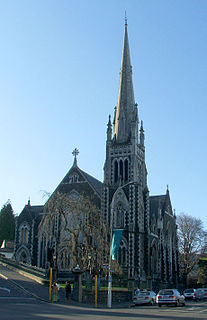 W
WKnox Church is a notable building in Dunedin, New Zealand. It houses the city's second Presbyterian congregation and is the city's largest church of any denomination. Situated close to the university at the northern end of the CBD on George Street it is visible from much of the central city.
 W
WLarnach Castle is a mock castle on the ridge of the Otago Peninsula within the limits of the city of Dunedin, New Zealand, close to the small settlement of Pukehiki. It is one of a few houses of this scale in New Zealand. The house was built by the prominent entrepreneur and politician, William Larnach. Since 1967, the castle has been privately owned by the Barker family, and opened as a tourist attraction, as "New Zealand's only castle".
 W
WThe Lyttelton Timeball Station is a heritage-registered time ball station and prominent local landmark in Lyttelton, New Zealand. The original station was significantly damaged by a series of earthquakes and aftershocks in 2010 and 2011, and finally collapsed on 13 June 2011 after a magnitude 6.4 aftershock. The tower was subsequently reconstructed, reopening in November 2018.
 W
WThe Mosgiel Woollen Mill is situated in Mosgiel, Dunedin, New Zealand, and was opened in 1871.
 W
WNugget Point Lighthouse is a lighthouse at Nugget Point in the Otago region of the South Island of New Zealand. It is owned and operated by Maritime New Zealand.
 W
WThe Government Buildings Historic Reserve, or more commonly referred to as the Old Government Buildings, is situated on Lambton Quay in Wellington. It was completed in 1876, and until 1998 was the second-largest wooden building in the world.
 W
WOruawharo Homestead is an historic homestead built in 1879 in Takapau, Central Hawke's Bay, New Zealand. It was designed by Wellington architect Charles Tringham in the Italianate style and built from native timbers for Sydney and Sophia Johnston by Sydney's father, the politician and merchant John Johnston. Johnston senior of Wellington was the original purchaser of the run in the 1850s. Sydney Johnston had the nearby Takapau township surveyed in 1876.
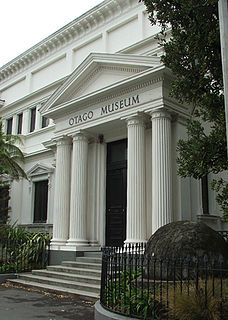 W
WThe Otago Museum is located in the city centre of Dunedin, New Zealand. It is adjacent to the University of Otago campus in Dunedin North, 1,500 metres northeast of the city centre. It is one of the city's leading attractions and has one of the largest museum collections in New Zealand. Natural science specimens and humanities artefacts from Otago, New Zealand and the world form the basis for long-term gallery displays. An interactive science centre within the Museum includes a large, immersive tropical butterfly rainforest environment.
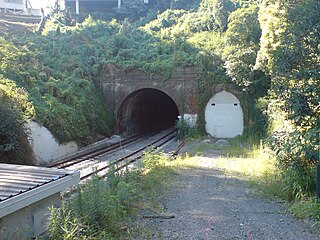 W
WThe Parnell Tunnel is a railway tunnel under Parnell, Auckland, New Zealand. It is 344.5 metres (1,130 ft) long, and is on the Newmarket Line.
 W
WRuatuna in Matakohe, New Zealand is a house built from kauri timber in 1877 overlooking the Kaipara Harbour. The house is the birthplace of Gordon Coates (1878–1943) who served as Prime Minister of New Zealand from 1925 to 1928. Ruatuna was registered by the New Zealand Historic Places Trust on 23 June 1983 and has registration number 7. The building has a category I listing.
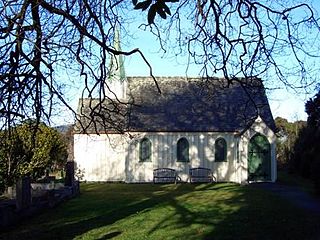 W
WSt Barnabas Church is a small wooden Anglican church in Warrington, New Zealand. It was built in 1872.
 W
WSt. James Anglican Church, in Kerikeri, New Zealand, is a congregation of the Anglican Church in Aotearoa in the Diocese of Auckland, currently operated as a mission of St. Paul's Church, Whangaroa. It is noted for its historic church building, which was built in 1878.
 W
WSt Joseph's Cathedral in Dunedin, New Zealand, is the Roman Catholic Cathedral for the Roman Catholic Diocese of Dunedin. It is located in City Rise, some 0.5 kilometres (0.31 mi) to the west of the city centre.
 W
WSt. Matthew's Church is an inner-city Anglican parish church, located on the City Rise in Dunedin, New Zealand. Designed by William Mason (1810-1897) the foundation stone was laid on 11 July 1873 and the building was consecrated on 3 December 1874. It cost 4,874 pounds to construct which wasn't paid off until 1901. It comfortably seated 750 people.
 W
WSt Paul's Church in Cashel Street, Christchurch, was a Category I heritage building registered by the New Zealand Historic Places Trust. It was demolished after the February 2011 Christchurch earthquake.
 W
WSt Paul's Anglican Church is a Category II listed heritage building in the Christchurch, New Zealand suburb of Papanui.
 W
WThe Seaview Asylum was a psychiatric hospital located to the north of Hokitika, in the West Coast Region of New Zealand's South Island. Once the town's biggest employer, the hospital was staffed by a superintendent, matron, attendants, and a labourer. A comprehensive history of the hospital, Sitivation 125: A History of Seaview Hospital, Hokitika and West Coast Mental Health Services, was written in 1997 by Warwick Brunton, now an Associate Dean at the University of Otago.
 W
WSydenham Heritage Church, originally known as the Colombo Street Methodist Church or Colombo Street Wesleyan Church or Colombo Road Wesleyan Church was a heritage-listed stone church building located in Sydenham, an inner suburb Christchurch, New Zealand. It was registered as an "Historic Place – Category II " by the New Zealand Historic Places Trust.
 W
WTe Aute College is a school in the Hawke's Bay region of New Zealand. It opened in 1854 with twelve pupils under Samuel Williams, an Anglican missionary, and nephew and son-in-law of Bishop William Williams. It has a strong Māori character.
 W
WThe University of Otago Registry Building, also known as the Clocktower Building, is a Victorian and later structure in the city of Dunedin, New Zealand. It stands next to the banks of the Water of Leith and is constructed from contrasting dark Leith Valley basalt and Oamaru stone, with a foundation of Port Chalmers breccia. The building houses the administrative centre of the university, and the office of the Vice-Chancellor. It has a Category I listing with Heritage New Zealand.